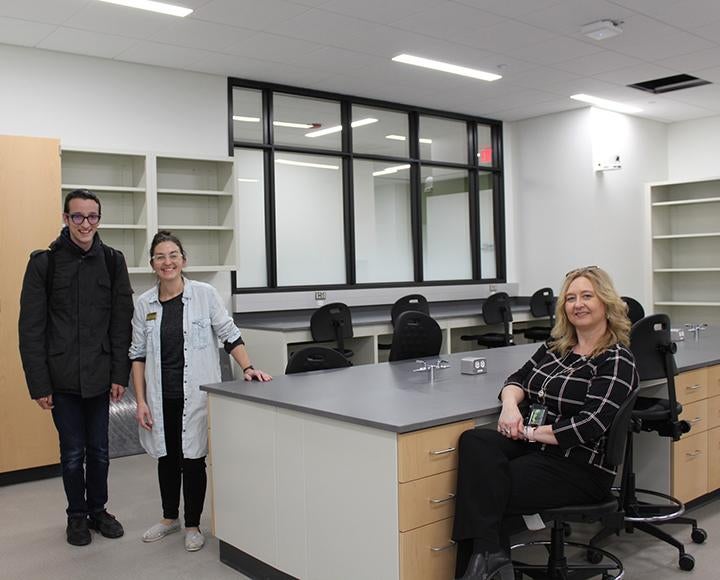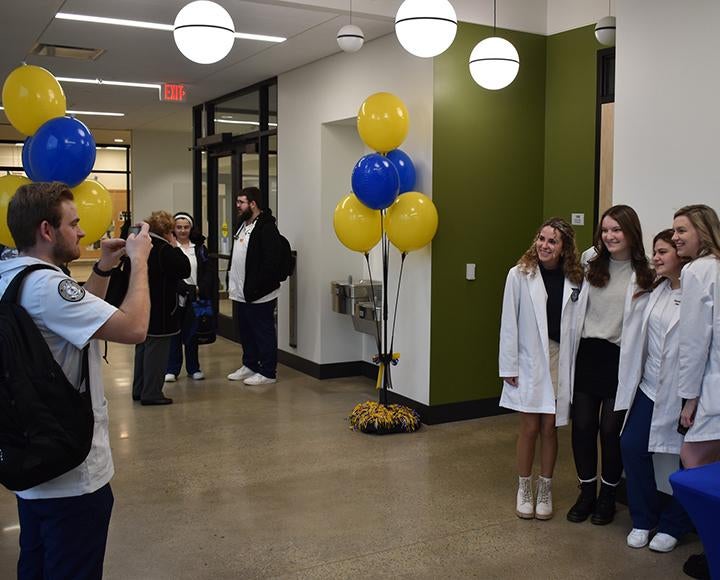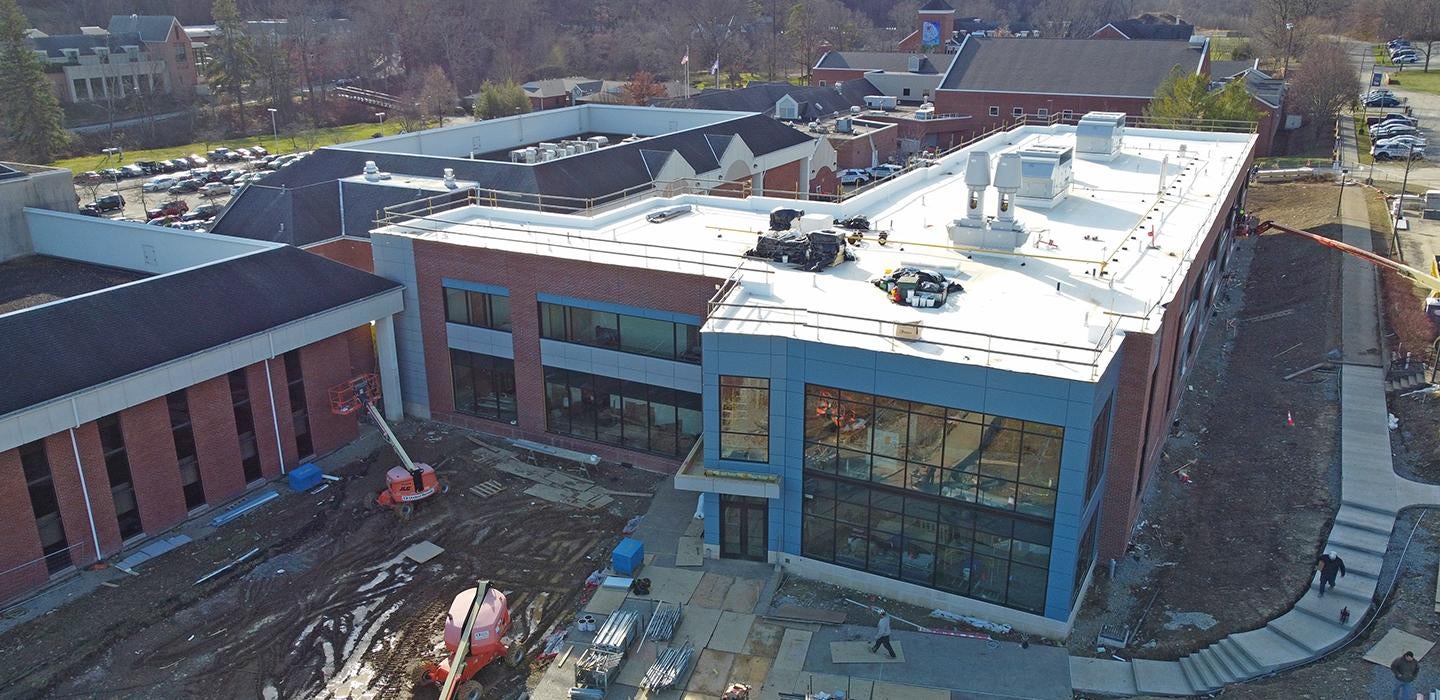
Subscribe to Pittwire Today
Get the most interesting and important stories from the University of Pittsburgh.The University of Pittsburgh at Greensburg celebrated the new year with the opening of its Life Sciences Building during a Jan. 12 ribbon-cutting in partnership with the Westmoreland County Chamber of Commerce.
Construction on the two-story, 32,085-square-foot building began in September 2021 and was completed in December 2022. The $19.5 million structure is connected through a new chemistry wing to Smith Hall, which has served as the center for science-related education since its construction in the 1970s. The new Life Sciences Building, designed by Pittsburgh-based MCF Architecture, will house nursing, health science, biology, microbiology and chemistry labs, as well as faculty offices and shared study spaces.
“At Pitt-Greensburg, approximately 500 students each year are majoring in the sciences and health-related disciplines,” said Robert Gregerson, president of Pitt-Greensburg. “The new Life Sciences Building will allow both the nursing program and our science programs to continue to grow — fulfilling an important need for space on our campus as well as fulfilling important needs in the region and the state.”
Rycon Construction out of Pittsburgh served as the general contractor for the project, which contributed an estimated $3 million in economic output to the region’s economy and an estimated 125 nonpermanent direct jobs. In addition, 31 permanent direct jobs will be created or retained and 112 jobs will be indirectly supported.
Barbara Barnhart, an instructor of biology, has worked closely with students in the Smith Hall labs.
“Working in small shared lab spaces meant that faculty and students needed to get creative and work collaboratively in order to succeed — and we did,” she said. “Our students are winning awards at conferences for their research. Just this past month, two of our students won second place for their research poster presentation at the annual meeting of the Allegheny Branch of the American Society for Microbiology. Adding new labs in the Life Sciences Building will provide more space for our faculty and students to not only offer lab-based courses, but to also work on capstone and honors projects. We are excited to see how our students and science programs advance with the opening of the Life Science Building.”


The new facility features seven laboratory spaces that science, nursing and nonscience disciplines will use: an anatomy and physiology lab, a general biology lab, a microbiology lab, an analytic chemistry lab, a general and advanced chemistry lab, an organic chemistry lab, and a chemistry prep space and research area for faculty. These will be coupled with a conference room, student study spaces and lobbies that lend themselves to study and conversation. Thanks to the generosity of the Elliott Group, study spaces and the lobbies on the first and second floors will bear its name. A third study space on the first floor is named the Dr. Guy M. and Nada L. Nicoletti Study Space. Two other study spaces will be named the Greensburg Foundation Family of Funds of The Community Foundation of Westmoreland County Study Spaces.
“The laboratories in the new Life Sciences Building will greatly expand our teaching and research capabilities in the sciences,” said Gregerson. “The design of the Life Sciences Building provides students with numerous studying and gathering spaces on both floors that are comfortable and highly functional. We have also included outdoor seating that will be very attractive to students during the warm weather months. The design includes very large windows that provide an amazing amount of natural light for all rooms, creating a welcoming environment for all who work, study or visit the spaces.”
The Bud and Ellen Smail High-Fidelity Simulation Suite is a major highlight of the nursing section. It consists of two simulation rooms and a control room that allows faculty to program mannequins with specific symptoms to create a realistic nursing experience. After the scenario is completed, the faculty meet with students to debrief on their performance and decisions.
Nursing students also will be able to learn and practice their skills in the new clinical lab. The Lawrence and Jacqualine Helkowski Tele-Health Room provides technology for nursing students to use in assessing patients and practice providing care in remote or underserved settings.
“Having a new state-of-the-art building where our students can earn their BSN [Bachelor of Science in Nursing] degrees in Westmoreland County means that we can admit more students into our nursing program, which is part of the University of Pittsburgh’s nationally ranked program,” said Marie Fioravanti, director of Pitt-Greensburg’s nursing program. She also noted that the BSN is the preferred degree by hospitals and clinics. “Our graduates will be able to serve our communities and help fill the need for more nurses — a need that is projected to grow by 6% over the next decade.”
The Life Sciences Building is also the second sustainable building on campus. Its proposed silver LEED rating will be confirmed in approximately 12 months. Frank A. Cassell Hall, which opened in 2012, was the campus’ first sustainable building with its gold LEED rating. Planning for the Life Sciences Building moved forward during Sharon P. Smith’s tenure as campus president and has come to fruition during Gregerson’s presidency.
Funding for the facility was provided through the University of Pittsburgh, the Commonwealth of Pennsylvania and Gov. Tom Wolf, as part of the Redevelopment Assistance Capital Program. Additional funding was raised through individuals, corporations and foundations, including funding from the Katherine Mabis McKenna Foundation in support of the nursing and health science facilities.
“We are grateful for the donors who have helped us to achieve this goal,” said Jodi Kraisinger, director of University Relations and Institutional Advancement. “We invite other members of our community to explore naming opportunities that create legacies for individuals, corporations, and the campus.” Anyone interested in learning more about naming opportunities in the new Life Sciences Building should contact Kraisinger at 724-836-9942 or kraising [at] pitt.edu.
The project met the Wolf administration’s workforce development goals, having a regional impact by increasing the number of STEM graduates who live and work in the state. On average, 88% of Pitt-Greensburg’s undergraduates are Pennsylvania residents, and approximately 70% of the campus’ alumni remain in the state after graduation.
— Susan Isola


